





What if I told you it is neither a banana or a palm tree?
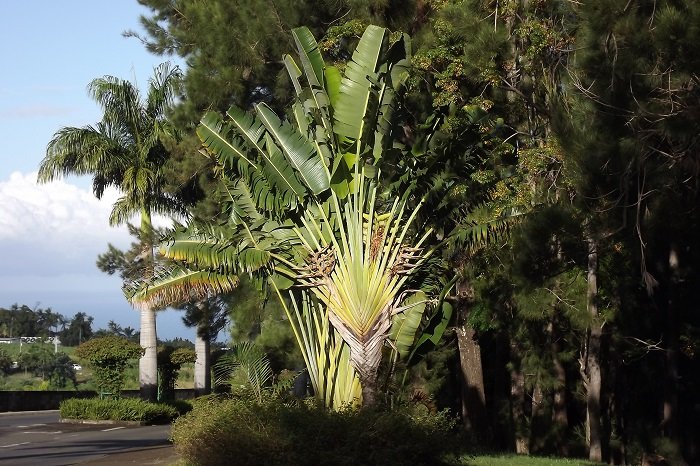 Yes, a traveler's tree. Not a traveling tree, so you will not find it in airport lounges or train platforms. It is devoted to travelers and actually comes from a part of the world where most readers have very probably never set foot so far. In order to study this plant in its original settings we have to travel to the Southwestern Indian Ocean, aka southeastern Africa. We can either hop from Mozambique across the Mozambique strait or fly directly to Antananarivo, the capital of Madagasikara, the Republic of Madagascar. For this is where we can encounter this surprising plant which Latin names gives tribute to its origin: Ravenala madagascariensis (formerly Urania madagascariensis). Note that the genera "Ravenala" was created by the French botanist Michel Andanson in 1763, he also use his own name for the 'Adansonia' genera which groups the African, Malagasy and Australian baobab species. From Antananarivo we will take a "taxi-brousse" to reach the lowlands where the plant thrives.
Yes, a traveler's tree. Not a traveling tree, so you will not find it in airport lounges or train platforms. It is devoted to travelers and actually comes from a part of the world where most readers have very probably never set foot so far. In order to study this plant in its original settings we have to travel to the Southwestern Indian Ocean, aka southeastern Africa. We can either hop from Mozambique across the Mozambique strait or fly directly to Antananarivo, the capital of Madagasikara, the Republic of Madagascar. For this is where we can encounter this surprising plant which Latin names gives tribute to its origin: Ravenala madagascariensis (formerly Urania madagascariensis). Note that the genera "Ravenala" was created by the French botanist Michel Andanson in 1763, he also use his own name for the 'Adansonia' genera which groups the African, Malagasy and Australian baobab species. From Antananarivo we will take a "taxi-brousse" to reach the lowlands where the plant thrives.
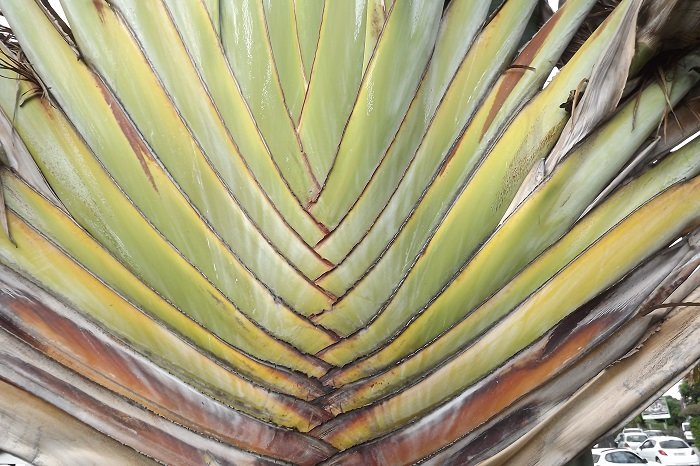
This tricky plant belongs to the Strelitziaceae family (it was classified in the Musaceae aka banana tree family for a long time), hence a close relative to the South-African Strelitzia reginae and S. nicolai but the genus Ravenala has only one species. The third genus within the family is also a mono-specific one this time from South America: Phenakospermum guyannense (from the Guyanas as you might expect) a poorly known plant rarely grown out of its native area where it thrives in wet lowlands. Anyway let us get back to our "ravinala" which in the Malagasy language means "forest leaves" and is a quite useful tree. Did you read that right? A tree? Yes although the plant can reach 8m (24 ft) high, it does not actually build a trunk made of true wood but a "stipe" like palm trees do, a fibrous structure lacking cambium. This high stipe bears a crown of large leaves - the petiole (leaf stalk) can reach 2m (6 feet long) and the leaf blade itself 4m (12 feet) so a grand total up to 6m (18 feet), not bad for a single leaf! They are arranged on a flat plane; hence giving the plant a distinctive fan-like look which is highly enjoyed for its ornamental feature and has been adopted as national symbol as well as logo for Air Madagascar company. It grows in clumps, somewhat like banana trees and Strelitzia, so when the main stipe becomes too high it can be cut back and other stipes will take over.
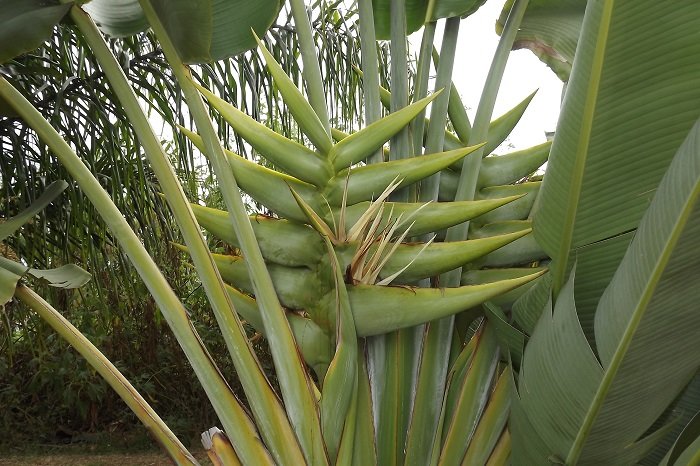
The "tree" is prized in Madagascar as all parts are used for building huts. The trunk provides boards called "rapaka" for the floor, leaf stalks called "falafa" are used for walls and the leaves or "raty" make like tiles for the roof. The starchy seeds are ground and cooked in milk to give a substantial food while young shoots and tender leaves are also edible and the colorful arilla which rounds the seeds can be processed so as to give a blue colored oil. The fibers can be used to make paper and the end shoot is cooked in the same way as palm heart. And last but not least you can get drinkable sap by slashing the stipe base with a machete, a much better idea than drinking the water trapped at the petiole base as this one usually contains a large amount of insects, frogs, bacterias and other inhabitants no one would want to ingest! So here we are back to the "travelers' tree" name, which usually refers to the rain water accumulated in the large petiole base as mentioned above but which I strongly discourage anyone to drink unless you want to visit local hospitals, which I doubt you would appreciate! The flowers are far from being showy; they are greenish-white petals and sepals which still attract birds for pollination though the job can also be done by bats or lemurs. Those flowers will produce fruits which are like woody pods with three parts rather hard to open. Once open one cannot but marvel at the stupendous color of the aril surrounding the seeds; they are electric blue! A rather unusual color which is designed to attract birds and small mammals in order to disseminate them and propagate the plant. This has revealed very effective on nearby Mauritius where the plant has gained the invasive plant status and indeed can be seen in every creek, rivulet and gullies.
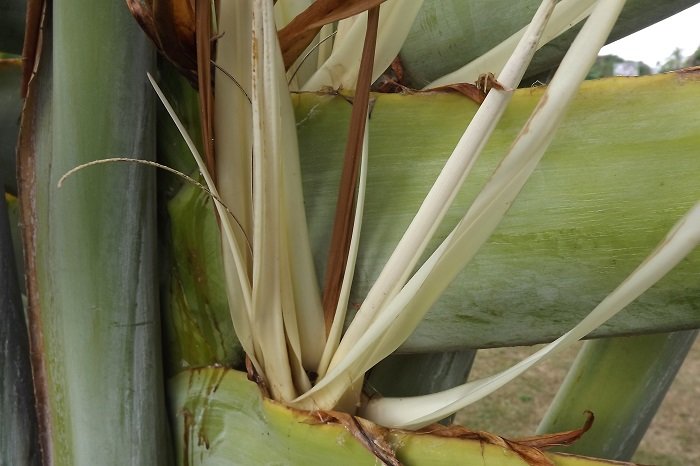
The plant is not a fussy one but its tropical origin makes it cold sensitive of course although it can take temperatures down to 20°F, it will do fine in USDA zones 9a to 11. Fresh seeds can start germinating in two weeks and will soon need to be repotted in large containers and in full ground later on. It will enjoy drained wet soils but can take sandy or even clayey ones, will enjoy full sun but can adapt to light shade. It can be seen in various parts of Southern California and Florida.
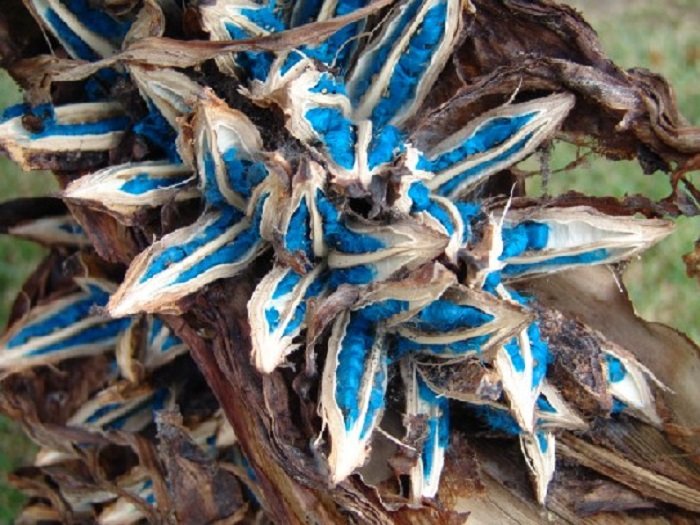
On Madagascar, locals believe that if you stand in front of a traveler's tree and make a wish with a pure and willing mind this wish will come true so next time you meet such a tree while strolling around give it a try, you may end up fulfilling your wildest dreams!
Copyright © www.100flowers.win Botanic Garden All Rights Reserved